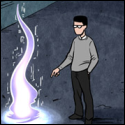|
Squalid posted:At times when coal was short they even burned penguins to run the boilers.
|
|
|
|

|
| # ? Jun 2, 2024 11:16 |
|
The Macquarie island episode of the Dollop is the best. E: episode 207.
|
|
|
Arquinsiel posted:This is simultaneously a hilarious and terrifying image. Puts a whole new mental image with the phrase pick up a penguin (chocolate bar in the UK).
|
|
|
|
|
This Finnish ABC book from 1871 (itself based on a German school book Grammatische Bilder-Fibel zur Schreibe-methode) gives an interesting insight into the mindset of people 150 years ago. 'Soldier shoots a man. Man shoots himself.'  'Boy hits dog with a stick.' 'Man hits horse with a whip.' 'Mother hits child with a cane.'  'Dog bites boy. Dog has bitten the boy.' 'Boy throws dog into lake. Boy has thrown dog into the lake.' 
|
|
|
|
Arquinsiel posted:Wikipedia says after that he got shot down a few times, so he clearly wasn't in an engineering unit all the time. Yeah, just in time to avoid the Battle of the Somme Brown either volunteers or is sent to the RFC, as an observer. It's here he gets hooked into air navigation as a subject, as at the time air navigation was done entirely by guessing and visuals. He gets shot down twice too, in the 5-6 months he was flying.
|
|
|
|
Rockets and people, Vol. 2 At the end of volume one, Korolev and Glushko [note: future famous Soviet rocket scientists] have made appearances in Germany. Our narrator, Boris Chertok, actually interviews Korolev not knowing really who the hell he is. It turns out that when somebody gets denounced and gulag'd, you first create an itemized list of all the bad things they are or have ever done, and then you burn that list in the fire of forgetfulness like that person never existed. Chertok gets the impression quickly that Korolev *really* knows his poo poo, as he seems to be judging how effective the entire Soviet rocket RnD efforts have been so far from just a few questions Korolev asks Chertok. Korolev also, Chertok mentions later, is giddy with freedom, and I can understand why. He's spent near a decade in the Gulags, and now, not only is he free, he's been given authority with the rank of a engineer colonel money, sent to Germany, and now he's driving his own goddamn car?! Chertok mentions that Korolev loved driving as it was very much an expression of "I'm free bitches!" that he had going on at his release. Glushko Chertok knew, at least by reputation. He had learned that in his rocket interceptor work, Glushko had set up a prison design bureau for rockets. He had also read one of Glushko's books. When a person gets gulag'd, all of their work is destroyed in public, while only the security services retained whatever copies were left. Though random coincidence, Chertok bought the book Glushko wrote in the late 1930s, only learning later in WW2 that this book was rare and dangerous to have. (Chertok was dreaming of some sort of applied electricity plasma rocket at the time.) Korolev also attended the British test shot of a captured V-2, disguised as an artillery captain. quote:All the members of our delegation, except for Korolev, had been sent to Cuxhaven with the ranks that had been conferred on them. But Korolev, on instructions from Moscow, had been ordered to change into a captain’s uniform with artillery shoulder boards and “cannons.” Apropos of this, Pobedonostsev said that “this artillery captain” provoked considerably more interest among the British intelligence officers who were watching our delegation than General Sokolov, Colonel Pobedonostsev, and the other high-ranking officers. One of the Brits, who spoke excellent Russian, asked Korolev straight out what he did. In accordance with his instructions and his cover story Sergey Pavlovich responded,“You can see that I am an artillery captain.” The Brit remarked, “Your forehead is too high for an artillery captain.What’s more, you clearly weren’t at the front judging by your lack of medals.”Yes, for our intelligence services this disguise was a resounding failure. Also note that the Soviet test firing staff working around Mittelwerk and Nordhausen always served visiting VIPs "rocket fuel", IE shots of the ethanol-water mix that was the fuel. The testers managed to boost the A4's engine output by tweaking the engine and the turbopumps, managed to take the 33 tons thrust to 35 tons. We also get a hint of what may be termed a personality flaw on the part of Glushko: quote:Two officers entered my office. I immediately recognized the colonel—it was Valentin Petrovich Glushko. The other officer, a lieutenant colonel, introduced himself simply as List. Both wore high quality uniform jackets, well-pressed trousers rather than tunics, jodhpurs, and boots. Glushko smiled slightly and said, “Well, it seems you and I have already met.” Evidently he remembered our meeting in Khimki. Nikolay Pilyugin dropped in and I introduced him as the institute’s chief engineer. I proposed that we all sit down and drink some tea or “something a bit stronger.” But Glushko, without sitting down, apologized and said that he needed emergency automobile assistance. “We were driving from Nordhausen and our car was pulling badly and smoking severely. We were suffocating from the smoke inside.They say that you have some good repair specialists.” One of the most important things built in Germany for future Soviet Rocketry was a train. The Nazis had been designing and building a V-2 Launch train, with all the facilities needed to launch a V-2, along with accommodations for the crew. The Soviets completed this, realizing this would be handy as hell to have at their future test range. Then, a VIP demands a copy of the first train be constructed, and this was done. These two trains were used for many years afterward, basically the home base for Soviet rocket science when out on their vast test range at Kapustin Yar. At the end of Volume One, no less than Korolev gives his opinion as to what the Soviets gained the most from German Rocketry. Stuff, yes, but according to him the most valuable thing gotten out of it was the identifying and concentrating of the people who'd go on to be key in the Soviet rocket industry. Vol. 2 Our narrator and comrades have managed to launch a few V-2s at Kapustin Yar on the Russian Steppe, along the way inventing a new term: bobik, which basically means software bug, except a bobik is a several hour delay caused by electronic fuckups. The new launches are thrilling, but reveal something badly wrong with the V-2's guidance system. Fortunately, they have with them Germans (who get their own railcar on the science train) in particular two scientists who worked on the V-2's guidance. They break out a test table and a guidance system, and soon find the problem: vibration is causing electrical noise between the gyroscope signal and the "amplifier-converter" that took the signal and translated it into action. The noise was blotting out the control signal. On the spot, in the lab car, the German scientists fabricated a line filter to let the control signal through and block the noise, which works in the next shot. This was apparently a problem never fixed on German A4s, which I think is a sign of how hard the Germans locked down the design once Heinrich Himmiler thought they had it. The German railcar personnel are lavishly rewarded with a prize of 15,000 rubels for each man and a jerry can of pure ethanol. (The Germans shared the alcohol with the Soviets as I think we can all agree a jerry can of pure alcohol is too much even for a railcar's worth of men.) Nebakenezzer fucked around with this message at 18:08 on Sep 29, 2019 |
|
|
|
Nenonen posted:This Finnish ABC book from 1871 (itself based on a German school book Grammatische Bilder-Fibel zur Schreibe-methode) gives an interesting insight into the mindset of people 150 years ago. What I'm reading from this is not that 19th century people were morbid, but rather that the Finns have not changed one bit in 150 years. A Finnish coworker showed me a picture from a Finnish children's book. It was a picture of a unremarkable gray cat. The accompanying text said, "The cat is not black. It is not white. It is gray. Sometimes life is gray.".
|
|
|
|
Whoa—this might be old news to the WWII buffs (or at least Cessna) but I just learned it following a chain of links from looking up the Pampanito—when USS Sealion sank the Kongo there was an audio recorder running in the conning tower because a war correspondent wanted to record a battle and got ridiculously, ridiculously lucky. You can listen to the recordings here; torpedoes are fired in record 2 starting at 1:45 and the first hit heard at 4:30. They also recorded the sounds of the subsequent depth charge run, although they got lucky and weren't spotted despite conducting the attack on the surface so the destroyers thought the attack came from the opposite side of the fleet. Quality is really bad as this is a copy of a copy of a copy and the Kongo recording also picks up a lot of sea and machine noise because the submariner who operated the recording equipment didn't realize how sensitive the mic was; there's also a recording of an attack on an oiler that's much clearer. Someone on youtube put together an adorably lo-fi amateur visualization that unfortunately suffers from some audio mixing issues (headphone users be aware): https://www.youtube.com/watch?v=w_J3v3snCxM And the Silent Service episode on the battle, which frustratingly plays a snippet of the recording in a much higher quality format at the beginning: https://www.youtube.com/watch?v=Gz8i7To0Ztg What other recordings of control centers during significant engagements exist?
|
|
|
|
Dunno if it counts as a major engagement, but a Lancaster bomber had a BBC reporter riding shotgun on a bombing run to Berlin, and the intercom recording is pretty intense: https://www.youtube.com/watch?v=MF5_hvE4WEA There's a VR "experience" thing available free on steam built around that recording. It's pretty cool if you have a VR headset
|
|
|
|
Radio comms between the pilots of several Huey gunships covering a troop extraction in Vietnam. https://www.youtube.com/watch?v=SuuDWd8SL7A Full audio: https://soundcloud.com/andrew-garrison/task-force-alpha-full-audio From: https://www.reddit.com/r/videos/comments/41ed1p/i_found_a_47_year_old_recording_of_myself_nearly/
|
|
|
|
SeanBeansShako posted:Puts a whole new mental image with the phrase pick up a penguin (chocolate bar in the UK).
|
|
|
|
What was the ratio of dead sailors to dead whales in the 19th century? I've read that in modern times a person dies for every 10,000 barrels of crude oil that are burned. I'd love to see that figure for whale oil.
|
|
|
|
Chamale posted:What was the ratio of dead sailors to dead whales in the 19th century? I've read that in modern times a person dies for every 10,000 barrels of crude oil that are burned. I'd love to see that figure for whale oil.
|
|
|
|
HEY GUNS posted:considering you don't have to drive up to the oil well and stab it to death in single combat... Calling it "single" combat seems like a disservice to the whales. They can take a bunch of us. also let's never forget that we have called the cops on whales: https://www.youtube.com/watch?v=Q4iQrDuf1r8
|
|
|
|
Edgar Allen Ho posted:Calling it "single" combat seems like a disservice to the whales. They can take a bunch of us. https://en.wikipedia.org/wiki/Essex_(whaleship) but the final stabbing is a single person which is why it's such a prestigious post in their culture; the rest of the boat rows him up to this.
|
|
|
|
In videos and images you can see puffs of smoke in the air when ships e.g. used their AA guns in WW2. What are those? Wouldn't the projectile just shoot as far as possible upwards or was it meant to explode at a certain height? If so, how was this achieved? Thanks!
|
|
|
|
Timed fuzes were used to make the shell explode at a certain time after firing, hopefully at the same height as an enemy aircraft. The Allies had sufficiently advanced electronics in the latter half of the war to introduce radar proximity fuzes that would explode near an object without having to have a time selected before firing. Artillery firing at ground targets also used time shells in the hope of making them explode just before impact for maximum effect (shrapnel spreading out instead of being directed upwards out of a hole in the ground), this was much easier to achieve with proximity fuzes. On a related note, how much of a hazard was falling shrapnel from AA shells and cartridge cases or bullets from aircraft to civilians beneath who weren't being directly targeted? GotLag fucked around with this message at 14:33 on Sep 30, 2019 |
|
|
|
GotLag posted:On a related note, how much of a hazard was falling shrapnel from AA shells and cartridge cases or bullets from aircraft to civilians beneath who weren't being directly targeted? Better than entire shells coming back down though.
|
|
|
|
lllllllllllllllllll posted:In videos and images you can see puffs of smoke in the air when ships e.g. used their AA guns in WW2. What are those? Wouldn't the projectile just shoot as far as possible upwards or was it meant to explode at a certain height? If so, how was this achieved? Thanks! Hitting an aircraft is really hard, and the best solution at the time was to have the shells explode nearby. Hell, it still kind of works like this - a lot of AA missiles detonate in proximity to the target rather than skin-on-skin. A cloud of quickly moving metal fragments shotgun-blasting vital systems can be more damaging than a single through and through hole. Usually this was done with a fuse that was dialed in based on estimated height, as mentioned earlier. On most USN ships it was done via a radar proximity fuse. This was only for use on ships because everyone was freaked out what would happen if a dud landed in a field in France and the Germans reverse engineered it. Towards the very end of the war you start seeing them used on contested land. Also in the artillery. Radar proximity fuses can make airbust artillery absolutely murderous. GotLag posted:On a related note, how much of a hazard was falling shrapnel from AA shells and cartridge cases or bullets from aircraft to civilians beneath who weren't being directly targeted? You see anecdotes from that era all over the place of civilian casualties caused by it. You can also find accounts of kids picking AA shrpanal up out of the streets after raids.
|
|
|
|
Some aircraft cannon shells were equipped with self-destruct fuses timed to go off a few seconds after firing, so you don't damage friendly targets in the ground after you miss the bomber you're shooting at
|
|
|
|
Nsfl for dead civilians: http://i.imgur.com/XcxiK.jpg Of course, these timed fuzes sometime fail. These people were hit by a US AA shell fired during the battle of Pearl Harbour. The timed fuze failed, and the shell exploded when it hit the ground behind the car, killing the entire family. 
|
|
|
|
I've read it was more like 20-50 civilian casualties (of course casualty doesn't mean dead) in Honolulu from US Navy AA shells and fragments falling on the city. This was all officially pinned on Japanese pilots strafing the city, but those guys weren't looking for anything that wasn't battleship shaped. Had the third strike not been called off, though, I imagine it might have killed some civilians (targeting the fuel depots). FuturePastNow fucked around with this message at 17:03 on Sep 30, 2019 |
|
|
|
GotLag posted:The Allies had sufficiently advanced electronics in the latter half of the war to introduce radar proximity fuzes that would explode near an object without having to have a time selected before firing.
|
|
|
|
Fangz posted:1. Radar doesn't exist. 5. A gross misunderstanding of the public's potential reaction to city bombing and a nation's desire to fight under those conditions.
|
|
|
|
Jobbo_Fett posted:5. A gross misunderstanding of the public's potential reaction to city bombing and a nation's desire to fight under those conditions. I don't know if I have a point here, it's just a thing.
|
|
|
|
Wasn't there also a widespread assumption that the bomber that always gets through would be packing chemical weapons?
|
|
|
|
P-Mack posted:Wasn't there also a widespread assumption that the bomber that always gets through would be packing chemical weapons? Yeah plus extrapolating from eg Guernica. The assumption in the 30s was that strategic bombing would actually be pretty much equivalent to a nuke.
|
|
|
|

|
|
|
|
FuturePastNow posted:I've read it was more like 20-50 civilian casualties (of course casualty doesn't mean dead) in Honolulu from US Navy AA shells and fragments falling on the city. This was all officially pinned on Japanese pilots strafing the city, but those guys weren't looking for anything that wasn't battleship shaped. Had the third strike not been called off, though, I imagine it might have killed some civilians (targeting the fuel depots). This actually brings a story my grandmother told of that day into perspective. Her father worked in the harbor and had just gotten off shift when the attack came in. The way she told it he crawled under cars to prevent getting strafed trying to get back. There was never any evidence of the Japanese doing that so I didn’t understand what was going on, but trying not to catch some shrapnel seems like a good reason to be under the cars.
|
|
|
|
Just because there's no evidence of it now doesn't mean he had any way of knowing that at the time. Smart move TBH.
|
|
|
|
feedmegin posted:Yeah plus extrapolating from eg Guernica. The assumption in the 30s was that strategic bombing would actually be pretty much equivalent to a nuke. https://www.youtube.com/watch?v=hOCYcgOnWUM If you’ve not seen Fog of War, I highly recommend.
|
|
|
|
Hahahahahaha
|
|
|
|
Rip the faultless IJN, whose actions made no difference one way or the other as to whether the USN would rain shells over Oahu. Can you believe these yankees though?
|
|
|
|
Edgar Allen Ho posted:Rip the faultless IJN, whose actions made no difference one way or the other as to whether the USN would rain shells over Oahu. I think you must have missed the context of this discussion, as nobody is arguing anything like that.
|
|
|
|
WW2 Data Part 4 of German cluster containers is up! First up is a series of incendiary containers under the BSB name, a rather interesting container that had numerous loadouts, and another which used bombs from a captured nation. Which nation was that? How was it modified to use those and how was it different from the German bombs it could carry as well? How exactly did BSB containers operate? Which of these containers was/were designed to be kept in the plane? All that and more at the blog!
|
|
|
|
Elyv posted:The Admiral Kuznetsov is going to retaliate by polluting the world super hard so that all walruses will die 
|
|
|
|
everydayfalls posted:This actually brings a story my grandmother told of that day into perspective. Her father worked in the harbor and had just gotten off shift when the attack came in. The way she told it he crawled under cars to prevent getting strafed trying to get back. There was never any evidence of the Japanese doing that so I didn’t understand what was going on, but trying not to catch some shrapnel seems like a good reason to be under the cars. They were definitely strafing the ships and the base to suppress antiaircraft fire, and to do as much damage as they could. I'm sure it was complete chaos in and around Pearl Harbor.
|
|
|
|
everydayfalls posted:This actually brings a story my grandmother told of that day into perspective. Her father worked in the harbor and had just gotten off shift when the attack came in. The way she told it he crawled under cars to prevent getting strafed trying to get back. There was never any evidence of the Japanese doing that so I didn’t understand what was going on, but trying not to catch some shrapnel seems like a good reason to be under the cars. Honolulu isn't directly next to Pearl Harbor, it's about 10 miles away. Back in the day there would have been even more of an obvious gap between Honolulu and Pearl Harbor/Hickam Air Field as Honolulu was so much smaller. Since he was at the Harbor proper, he definitely was dodging the Japanese planes supressing and causing general chaos, as well as the shrapnel. It was absolute chaos that day. Edit: No joke, I worked in a building at JBPHH that still has bullet holes from the attack. Don Gato fucked around with this message at 05:22 on Oct 1, 2019 |
|
|
|
https://twitter.com/PearlHarborAvi/status/707820828751220737?s=20
|
|
|
|

|
| # ? Jun 2, 2024 11:16 |
|
Don Gato posted:Honolulu isn't directly next to Pearl Harbor, it's about 10 miles away. Back in the day there would have been even more of an obvious gap between Honolulu and Pearl Harbor/Hickam Air Field as Honolulu was so much smaller. Since he was at the Harbor proper, he definitely was dodging the Japanese planes supressing and causing general chaos, as well as the shrapnel. It was absolute chaos that day. I don't doubt that the harbor was strafed that day but the way the story was told by my grandmother was that the Japanese where strafing the civilian cars on the road far from the harbor. I realized as I got older that there was a certain underlying current of racism in the story and the way she recounted it. I remember watching a Pearl Harbor documentary with my grandparents in the late 90's and a Japanese-American was relating his disbelief at seeing Japanese planes attacking and they discredited his recounting with "they where all on their roofs cheering the attack on". The one event (and probably years of war propaganda that followed) formed a lasting impression on both of them.
|
|
|









































